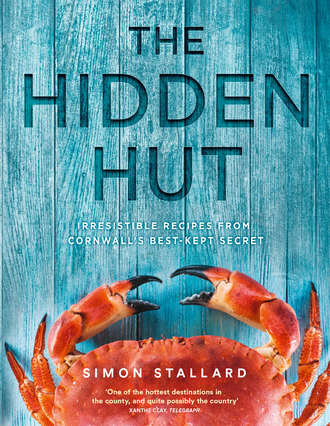
Полная версия
The Hidden Hut: Irresistible Recipes from Cornwall’s Best-kept Secret
Put the figs, cut side up, on a baking tray and drizzle over the star anise butter. Roast for 15–20 minutes until the figs are tender.
Slice the bread and toast it, then spread the hot toast with the cinnamon butter. Top with the figs, sprinkle with flaked almonds and serve with honey, ricotta and a sprinkling of lemon zest.
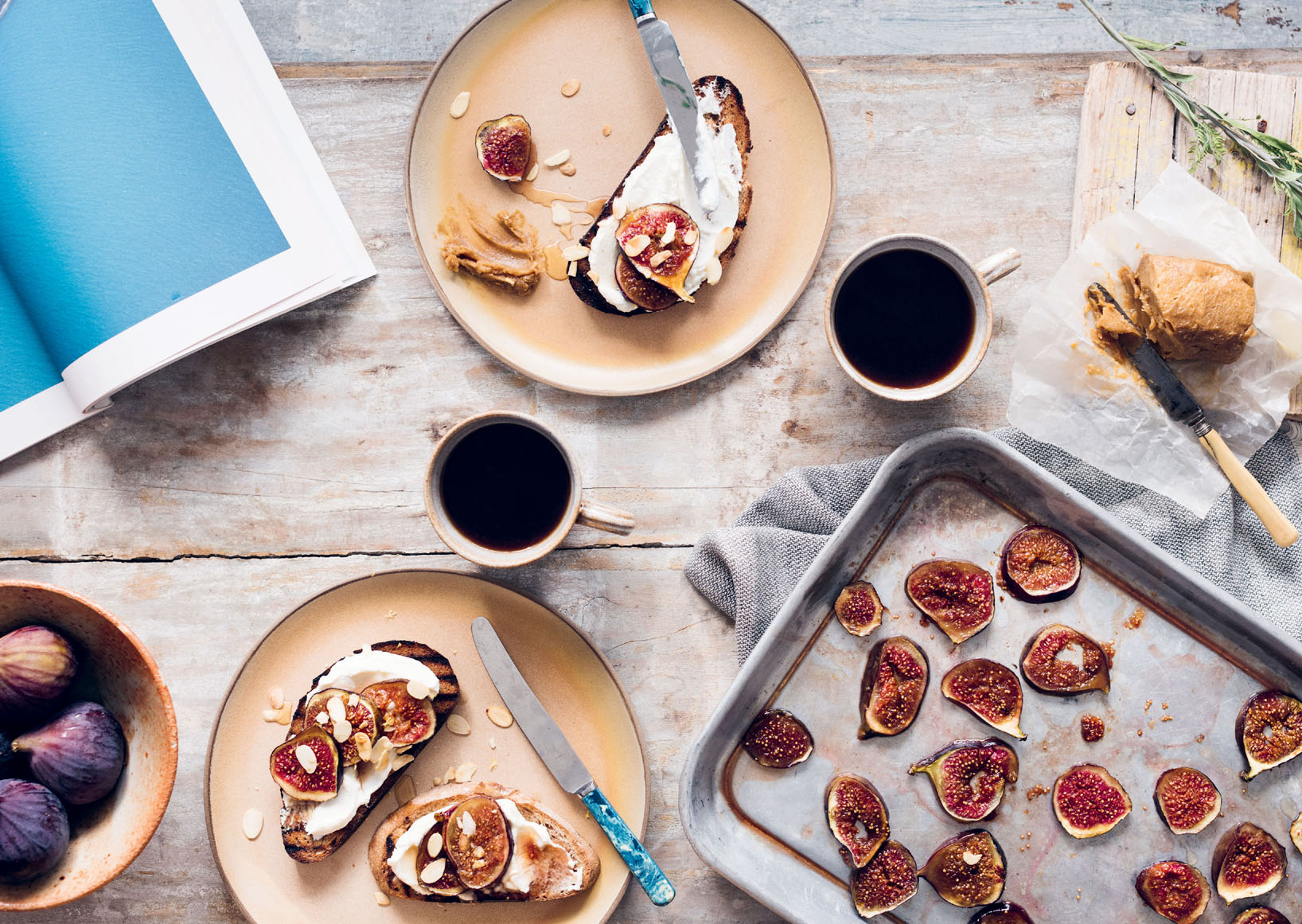
GRILLED MACKEREL WITH A WARM CORNISH SPLIT AND HORSERADISH SOURED CREAM
We serve these filled splits during the annual Portscatho Fish Festival. The mackerel comes in straight from the boats and onto our big wood-fired grills on the harbour jetty. Try to use the freshest possible mackerel. If you can, choose mackerel that are whole so that you can check if the eyes are clear and bright. Then ask the fishmonger to fillet and pin-bone them for you, leaving the skin on.
Splits are like a proven scone. They are well worth the effort, especially when served warm from the oven. The subtle sweetness of the split and the punch from the horseradish really complement the oily mackerel. If you have a sweet tooth, try a bit of gooseberry jam in there too; it might just make your day.
Serves 6
12 mackerel fillets, about 100g each, boned (see here), with skin
sunflower oil, for frying
100g watercress
sea salt and freshly ground black pepper
gooseberry jam (optional), to serve
FOR THE SPLITS
10g active dried yeast
1 rounded tsp caster sugar
200ml whole milk, lukewarm
265g strong white bread flour, plus extra for dusting
100g plain flour
1 tsp fine sea salt
60g unsalted butter, softened, plus extra for greasing
1 egg yolk, lightly beaten
a little peeled and grated fresh horseradish
FOR THE HORSERADISH SOURED CREAM
4 tbsp soured cream
30g peeled and grated fresh horseradish
2 tbsp lemon juice
1 tsp sea salt
½ tsp freshly ground black pepper
To make the splits, put the yeast in a bowl and mix in the sugar and milk. Leave to stand for 5 minutes to allow the yeast to activate.
Sift the bread flour and plain flour, and the salt, into a large mixing bowl, then rub the butter into the flour mix using your fingertips. Make a well in the centre, add the yeasty milk and mix to form a dough. Tip onto a floured work surface and knead for 10 minutes. Put in a clean bowl, cover with a damp tea towel or cling film and leave in a warm place to rise for 1 hour or until doubled in size.
Remove the dough from the bowl, knead again for 2 minutes, then shape into 6 rolls. Put these on a greased baking sheet. Brush with the egg yolk and sprinkle over a little grated horseradish. Leave to rise again in a warm place for 45 minutes. Preheat the oven to 200°C (180°C fan oven) gas mark 6.
Bake the rolls for 25–30 minutes until light golden — to test they are cooked, tap the bottom of one of the rolls; it should sound hollow when ready. Cool slightly on a wire rack.
To make the horseradish soured cream, mix all the ingredients together a bowl.
Heat a non-stick frying pan over a medium-high heat. Season the mackerel well with salt and pepper. Heat 2 tablespoons of oil in the frying pan and add the fillets skin-side down — cook in batches of 2–4 fillets, depending on the size of your pan. Press down for the first 10 seconds so that the mackerel doesn’t curl up. Cook for 2 minutes until crispy, then flip over and cook for a further 30 seconds on the other side. Repeat with the remaining fillets.
To serve, cut the warm splits horizontally like a burger bun, put two mackerel fillets in each bun along with a good spoonful of the horseradish soured cream and some watercress. If you have any gooseberry jam in the fridge, pop this out on the table, too, to add to the mackerel.
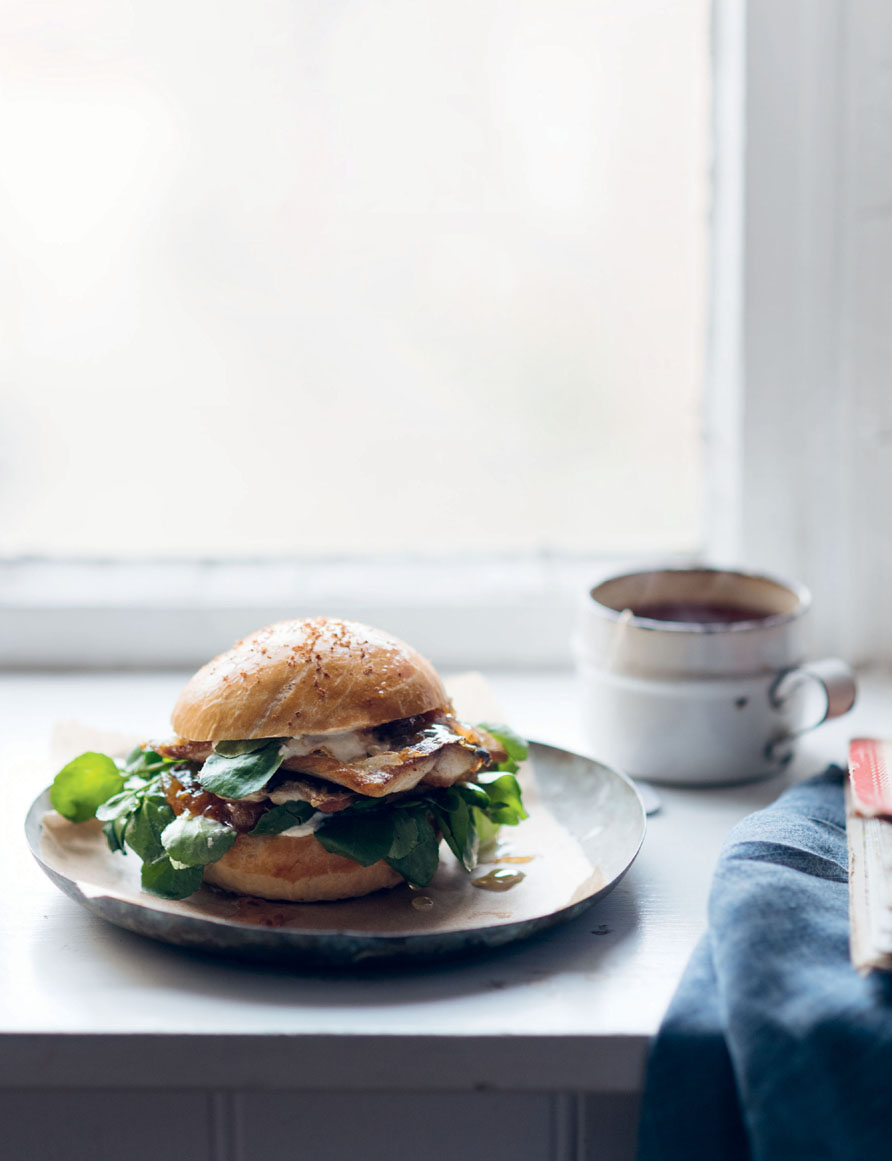
FLUFFIEST SMOKED HADDOCK OMELETTE
This is no ordinary omelette. Light, fluffy and delicately smokey, the yolks added towards the end give it a beautiful self-saucing finish when cut into.
Serves 4
300g skinless, boneless smoked haddock fillet
10 eggs
100ml double cream
8 spring onions, finely chopped
a small bunch of coriander, leaves chopped
1 tbsp olive oil
50g Cheddar cheese, finely grated
sea salt (if needed) and freshly ground black pepper
Put the haddock in a bowl and pour hot water from the kettle over it, then leave it to poach for 2 minutes. Drain and flake the fish into large chunks.
Separate four of the eggs, leaving the yolks in the shells for now. Put the whites in a clean, grease-free bowl and whisk them using an electric hand whisk until firm peaks form.
In a separate large bowl, whisk the remaining six whole eggs with the cream and season with pepper (you probably won’t need much salt, if any, as the haddock is quite salty). Fold the egg whites into the egg and cream mixture, being careful not to knock out too much of the air. Using a spatula, quickly fold in the flaked haddock, spring onions and coriander.
Preheat the grill to high. Heat the oil in a frying pan with a heatproof handle over a medium heat. Pour the egg mix into the pan and use a spatula to move the mix around a bit so that it starts to cook evenly. Pop a lid on and leave to cook for 5 minutes in the pan or until well set on the bottom.
Remove the pan from the heat and gently tip the four egg yolks from their shells onto the top of the omelette. Sprinkle the top with the cheese and put the pan under the grill for 3–4 minutes until the omelette is turning golden on top and is cooked throughout, but the egg yolks are still runny. Serve immediately.
TOPPED CORNISH POTATO CAKES
Cornish potato cakes stacked up with sausage patties, blistered tomatoes and crispy potato skins. By popping a few baking potatoes into the oven first thing, you’re well on the way to making a cooked brunch that will set you up for the day.
Serves 4
4 baking potatoes, about 200g each
480g of your favourite sausages
olive oil, for brushing and shallow-frying
1 tsp flaked sea salt
40g butter, melted
10g plain flour, for dusting
sea salt and freshly ground black pepper
basil leaves, to garnish
FOR THE BLISTERED TOMATOES
400g cherry tomatoes, sliced in half
4 spring onions, finely shredded
a squeeze of lemon juice
1 tbsp olive oil
1 tsp nigella (black onion) seeds
First thing in the morning, put the potatoes into the oven, set it for 200°C (180°C fan oven) gas mark 6 and leave to bake for 1–1½ hours or until soft. Cut each potato in half and scoop out the flesh into a bowl, keeping the skins. Leave until ready to use.
Preheat the oven to 190°C (170°C fan oven) gas mark 5. Remove the skins from the sausages and form the sausagemeat into eight small patties. Put to one side.
Thoroughly scrape off any remaining mash from the potato skins and cut the skins into 2.5cm slices. Brush with olive oil and sprinkle with the flaked sea salt. Put onto a baking tray and cook in the oven for 10 minutes.
Meanwhile, mash the potato with a fork, then add the butter and season with salt and pepper. Mix well. Divide the mash into eight even balls and gently flatten the top and bottom of each slightly, then dust in the flour.
Heat the olive oil for shallow-frying in a frying pan over a medium-high heat and pan-fry the balls for 1 minute on each side or until browned. Set these on a baking sheet and cook in the oven for 8 minutes.
Give your frying pan a quick clean, then fry the sausage patties in olive oil for 2 minutes on each side or until golden and crispy. Turn the oven right down to 110°C (90°C fan oven) gas mark ¼ and pop the patties in with the potato cakes to keep warm.
For the tomatoes, turn up the heat under the frying pan and cook the tomatoes for 2 minutes, turning once. Try not to stir them too much. Throw in the spring onions and add the lemon juice, oil and nigella seeds. Cook for 1 minute or so to lightly wilt the onions.
Serve the potato cakes topped with the sausage patties. Spoon oven the tomatoes and spring onions, and top with the crispy potato skins and some fresh basil leaves.
CHILLI SAFFRON TOAST WITH CRISPY BACON
Here’s one for chilli lovers. Head down to your local bakery to pick up a Cornish saffron loaf, and get the frying pan on for this eggy bread with a twist. The fiery green chilli and coriander really wake everything up. These toasts are great with a bowl of Greek yogurt on the side.
Serves 4
2 large eggs, beaten
16 rashers of smoked streaky bacon
40g butter
4 slices of 1 large saffron loaf, about 2.5cm thick and 100g each
4 tsp wild honey
1–2 small green finger chillies, to taste — depending on how hot you like it — finely chopped
a bunch of coriander, leaves roughly chopped
sea salt and freshly ground black pepper
Season the eggs with salt and pepper, then pour them into a deep saucer or shallow bowl and put to one side. This is for dipping the saffron bread into.
Preheat the oven to 195°C (175°C fan oven) gas mark 5½ and line a baking tray with baking parchment. Lay out the rashers of bacon on the prepared baking tray. Lay over a second layer of parchment on top of the bacon and put another baking tray on the top to keep the bacon flat and stop it curling up while it cooks. To get crispy bacon, cook in the oven for 15 minutes.
In the meantime, melt the butter in a frying pan over a medium heat. Dip each slice of saffron bread into the egg and press down to soak up the egg, then turn over so that both sides are soaked equally. Fry for 2 minutes on each side or until golden brown. When all the slices are fried, put them onto a baking tray and pop them in the oven with the bacon to keep hot until you’re ready to serve.
Put the crispy bacon on top of the saffron toast and drizzle with honey. Serve sprinkled with the chillies and coriander.
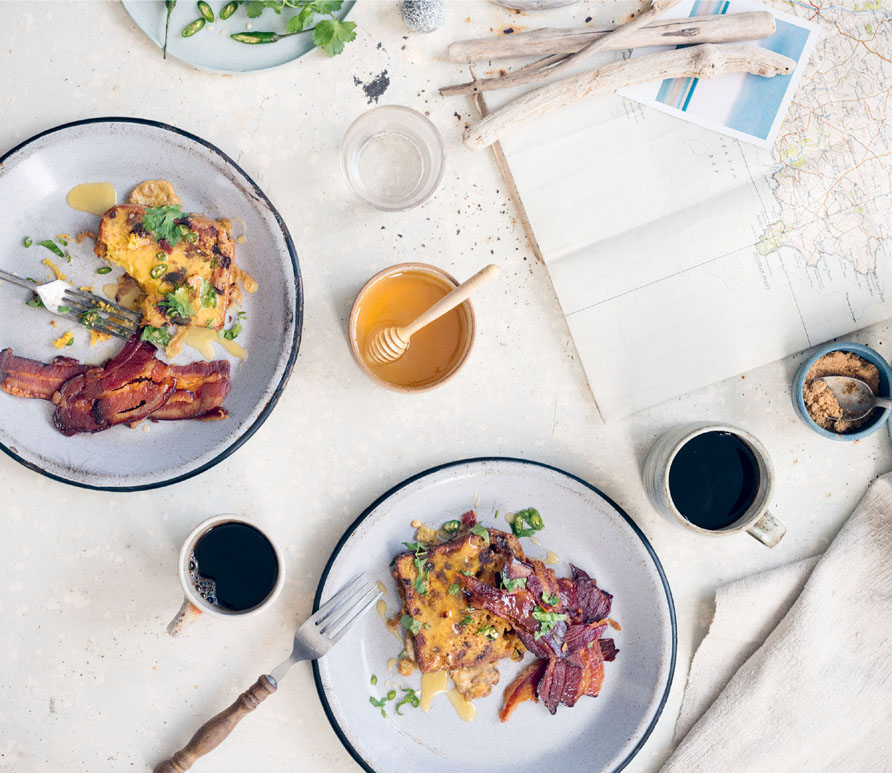
ASPARAGUS BAKED EGGS, POTATO RÖSTI AND FIELD MUSHROOMS
For those fresh spring mornings when asparagus is in season and calling out for runny yolks. These asparagus baked eggs are served with golden rösti, richly flavoured field mushrooms and a citrusy tarragon hollandaise sauce for a really wholesome vegetarian breakfast.
FEAST
Serves 8
300g Cornish asparagus, tough ends snapped off
50g butter
2 tbsp light olive oil
2 white onions, finely sliced
8 eggs
sea salt and freshly ground black pepper
FOR THE POTATO RÖSTI
2kg potatoes, peeled and coarsely grated
2 tsp fine sea salt
1 tsp freshly ground black pepper
100g butter
FOR THE TARRAGON HOLLANDAISE
250g butter
2 large egg yolks
1 tbsp white wine vinegar
juice of ¼ large lemon, or to taste
1 tbsp finely chopped tarragon leaves
FOR THE FIELD MUSHROOMS
2 tbsp light olive oil
8 field mushrooms, peeled and cut into 1cm slices
50g butter
Preheat the oven to 170°C (150°C fan oven) gas mark 3. Chop the tips off the asparagus and put them to one side. Using a swivel vegetable peeler, pare the asparagus into ribbons.
Melt the butter with the oil in a large frying pan over a medium heat. Add the onions and a good pinch of salt and pepper, then cook for 8–10 minutes until lightly caramelised. Add the asparagus ribbons and cook for a further 1 minute.
In a small roasting tin, lay out two-thirds of the onion and asparagus mix, then crack the eggs over the top, leaving a gap between each one. Put the remaining onions and asparagus ribbons, and the asparagus tips, over the top to protect the eggs. Lightly season with salt and pepper and set aside.
To make the rösti, put the grated potato in large mixing bowl and add the salt and pepper. Melt the butter in a saucepan over a low heat. Pour the melted butter over the potato and mix well. Once well coated, split the mixture in half and press it into two non-stick frying pans. Cook over a medium heat for 4 minutes or until the edges start to become golden.
Hold a chopping board or a plate over the frying pan and flip the pan over to turn the rösti out onto the board, then sweep the rösti back into the pan to cook the other side. Do the same with the other pan of rösti. Cook on this side for 2 minutes or until turning golden. Transfer the rösti from each pan to a baking tray.
Put the rösti, and the roasting tin with the asparagus mix, into the oven, and bake for 15 minutes or until the rösti is golden all over and the egg whites are set but the yolks are still runny.
While the rösti and asparagus are cooking, make the hollandaise. Put the butter in a saucepan over a medium-low heat and gently melt, then set aside. Put the egg yolks and vinegar in a heatproof bowl set over a saucepan of gently simmering water, making sure the base of the bowl doesn’t touch the water, and whisk continuously until the eggs have thickened to the consistency of mayonnaise. If it becomes too thick, add a tiny splash of warm water.
Take off the heat and slowly whisk in the melted butter in a steady stream, discarding the white sediment at the bottom of the pan. Add 1 tablespoon of warm water, most of the lemon juice and all the tarragon, then season with salt and pepper and add more lemon if required.
To cook the mushrooms, heat the oil in a large saucepan over a medium heat and add the mushrooms and a good pinch of salt and pepper. Cook for 2 minutes, then add the butter and cook for 2 minutes more. Serve the asparagus baked eggs with the rösti, mushrooms and tarragon hollandaise.
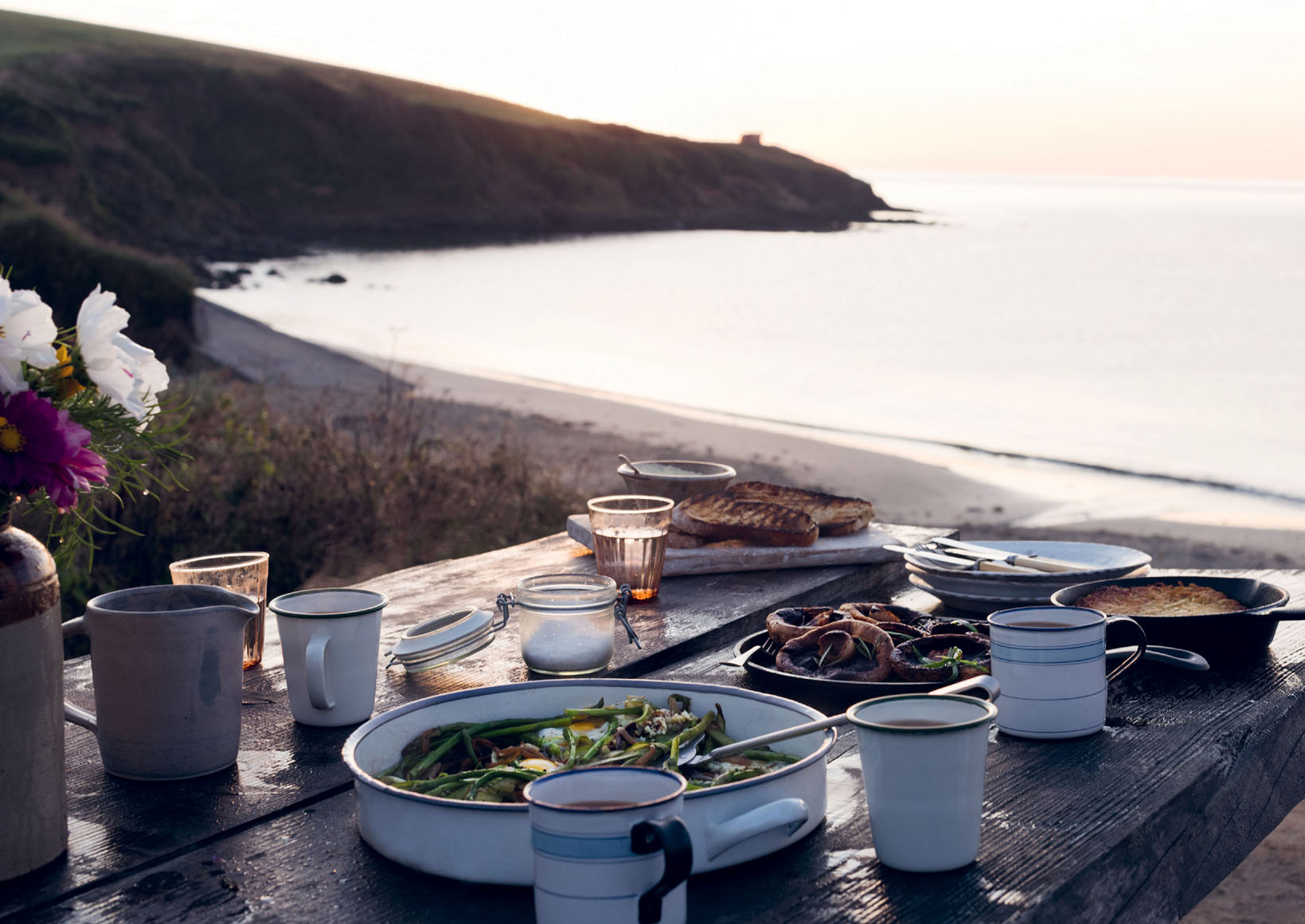
2
Noon

Lunch is the main meal to be served from our beach kitchen. The menu is chalked up daily, often twice daily if it’s busy, and we whizz through produce. Our food doesn’t follow any particular cuisine; instead, we allow ourselves to be influenced by the seasons and the fresh produce they bring, and even by the variable weather. Cornish soul food might be a way to describe it.
When browsing the recipes for inspiration, let yourself be guided by the day around you. If it’s a hot, sunny day, bring out the salads and grilled fish. If it’s cold and blustery, warm up with spiced dhals and slow-cooked joints of lamb.
If you’re interested in having a go at building your own wood grill or fire pit, there is a feature (see here) that takes you through it step by step. Though I warn you: once you start cooking with fire, it can get pretty addictive!
Soup Sundays at the Hidden Hut
Come wind, rain or shine, a warming bowl of soup can solve everything.
Soup Sundays have become a bit of an institution at the Hidden Hut. The appeal of hugging a warm pot of soup after a long coastal walk is pretty unbeatable. The atmosphere on these days is great — everybody is in day-off mode in their wellies or walking boots. Dogs and children play on the beach. The super-brave even swim here from the village! The place becomes a hub where you end up bumping into old friends and meeting new ones.
Soup Sundays for us are all about the spring and autumn months when the temperature starts to dip and the best soup veggies are in season. We get up early in the morning and prep mountains of produce to make fresh stocks, adding flavours layer by layer. The night before, we roast chicken, simmer turbot frames (bones), braise oxtail and prove bread; everything is done from scratch. At noon we chalk up around five or six fresh soups onto the boards and offer them all for a fiver with bread, butter and a selection of toppings. For us, soups aren’t an apologetic starter made from yesterday’s leftovers; they are served as our main meal of the day on our busiest day of the week!
Humble and soul-warming, soup is a delicious treat at home, too. Just like at the hut, you can transform simple homemade soups into a more substantial offering with a selection of toppings — crispy onions, fried herbs, croutons, grated cheese, toasted seeds and nuts — whatever takes your fancy. Bread is important, too. If you can, go for an uncut fresh loaf or bake your own. If not, just toast what you’ve got topped with grilled cheese!

© Sally Mitchell
PUMPKIN GINGER SOUP WITH CHESTNUTS AND CRISPY FRIED SAGE
A warming autumnal soup — ideal for blustery days. It is great with a side of melted cheese on toast.
Serves 4–6
1kg peeled and deseeded pumpkin or butternut squash, cut into wedges
2 tbsp olive oil, plus extra for drizzling
1 tbsp honey
1 large white onion, diced
2 garlic cloves, finely chopped
30g piece of fresh root ginger, peeled and finely chopped
850ml vegetable stock
½ tsp freshly grated nutmeg
½ tsp ground cinnamon
sunflower oil, for shallow-frying
a few sage leaves
30ml double cream
100g peeled cooked chestnuts, roughly chopped
sea salt and freshly ground black pepper
Preheat the oven to 220°C (200°C fan oven) gas mark 7. Put the pumpkin in a roasting tin and drizzle with olive oil and the honey. Season with salt and pepper, and mix everything together well. Roast in the oven for 30–40 minutes until tender and caramelised.
While the pumpkin is roasting, heat the 2 tablespoons of olive oil in a large saucepan over a medium heat and sweat off the onion, garlic and ginger, until the onion is tender. Add the cooked pumpkin to the pan, along with the stock, nutmeg and cinnamon, bring to the boil, then reduce the heat and simmer everything together for 10 minutes.
Meanwhile, heat 1cm of sunflower oil in a small frying pan over a high heat. Flash-fry the sage for 30 seconds or until crispy, then drain on kitchen paper and sprinkle with salt.
Take the soup pan off the heat and stir in the cream. Blend the soup using a blender or food processor, then adjust the seasoning to taste. Serve the soup topped with the chestnuts and crispy sage leaves.
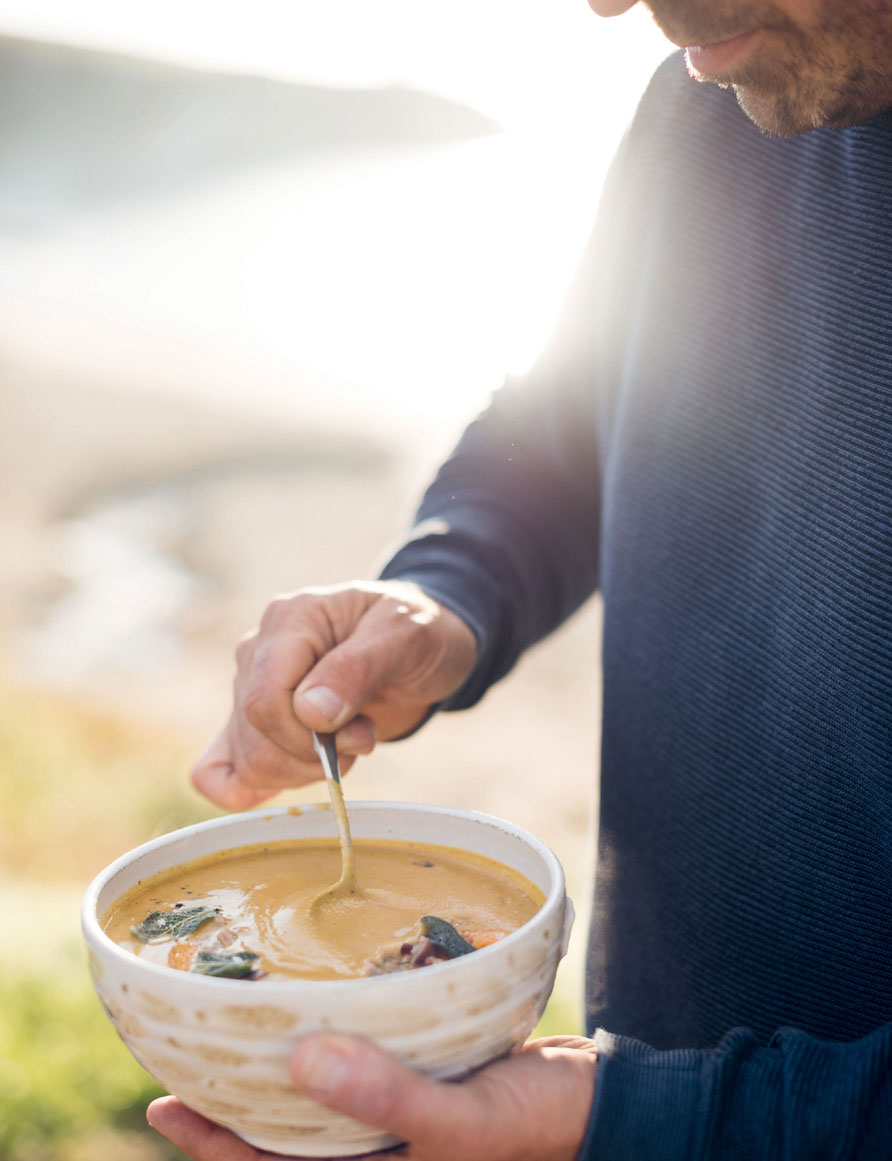
ROASTED SQUASH AND CAULIFLOWER DHAL
In the autumn, when the coastal path is swarming with hikers, veggie dhal absolutely flies out of our kitchen. If you swap the yogurt for a non-dairy alternative, you have yourself a tasty and substantial vegan lunch.
Serves 4
1 butternut squash, peeled, deseeded and cut into large chunks
1 cauliflower, cut into large florets
2 tbsp sunflower oil
2 tbsp coconut oil
1 tbsp mustard seeds
2 onions, diced
3 garlic cloves, finely chopped
50g piece of fresh root ginger, peeled and grated
2 green chillies, deseeded and finely chopped
1 tbsp ground cumin
1 tbsp ground coriander
1 tsp paprika
1 tsp ground turmeric
1 tbsp curry powder
2 tomatoes, deseeded and chopped
1 vegetable stock cube
400ml coconut milk
350g red lentils
1 tbsp caster sugar
juice of 2 lemons
1 tbsp garam masala
100g spinach
2 tbsp chopped coriander leaves
100g natural yogurt
4 spring onions, sliced
sea salt and freshly ground black pepper
toasted flatbreads, to serve
Preheat the oven to 220°C (200°C fan oven) gas mark 7. Put the squash and cauliflower in a roasting tin and add the sunflower oil, then season with salt and pepper. Toss to coat, then roast in the oven for 20 minutes. Put to one side.
Heat the coconut oil in a saucepan over a medium heat and fry the mustard seeds, onions, garlic, ginger and chillies for 5 minutes or until softened. Add the cumin, coriander, paprika, turmeric and curry powder, and cook for 1 minute.
Add the tomatoes to the pan and cook for 30 seconds, then crumble in the stock cube and add 1 litre water and the coconut milk. Bring to the boil. Add the lentils and cook over a medium heat for 20 minutes.
Add the sugar to the pan, followed by the lemon juice, garam masala, spinach, coriander and half the yogurt, then cook for a further 1 minute. Season with salt and pepper to taste.
Tip the roasted cauliflower and squash into the pan, stir then sprinkle over the spring onions and serve with the remaining yogurt and toasted flatbreads.
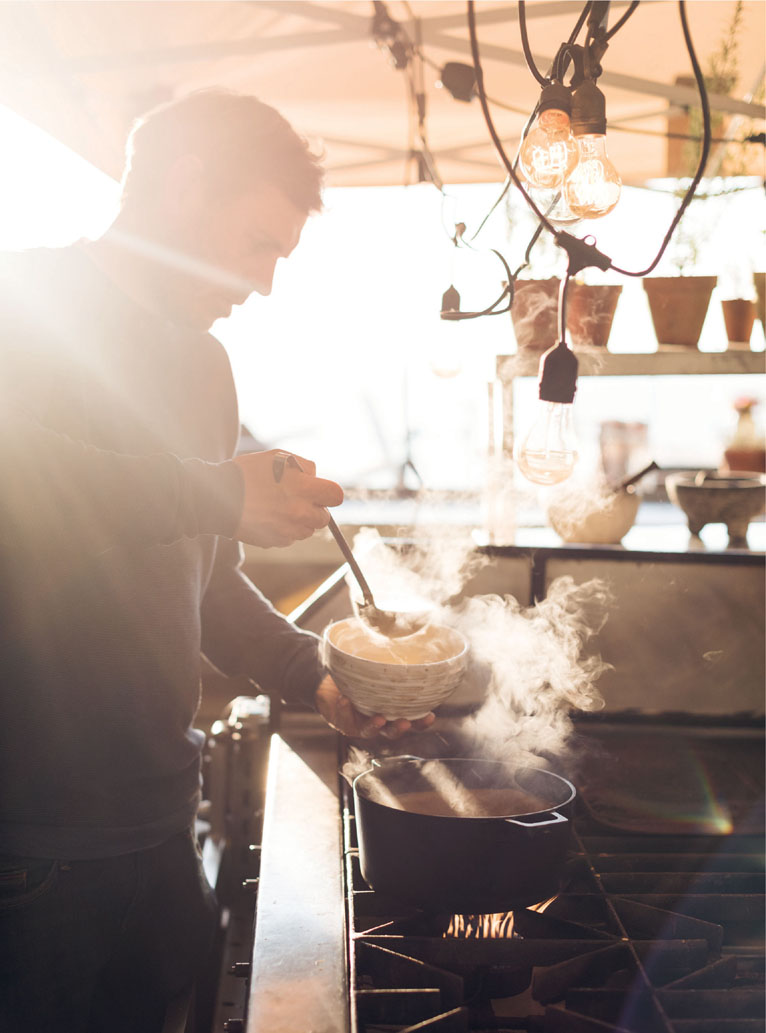
CHICKEN AND WILD GARLIC SOUP
Wild garlic is abundant in local woodlands. They are small ground-covering plants with broad leaves and a little cluster of white flowers during the spring, and they are often found alongside bluebells. If you come across any wild garlic when you are out and about, this recipe is a lovely way to make the best of it. This is an enriching dish full of the flavours of spring.
Homemade stock really is better made with the whole bird, so buy a whole chicken and joint it. Use the carcass and legs for this recipe and freeze the breasts (or use them in the Charred Chicken and Squash Salad here). To make the soup more substantial, cook 200g dried rice noodles and put them in the bowl before adding the soup, if you like.
Serves 4–6
3 tbsp sunflower oil, plus extra for roasting
1 large chicken, jointed (you can ask your butcher to do this) and breasts reserved for another recipe
3 celery sticks, roughly diced
1 onion, roughly diced
1 leek, roughly chopped
1 large garlic bulb, cloves peeled
100g wild garlic leaves, roughly sliced (keep the flowers if you have them)
4 spring onions, finely sliced on the diagonal
a small handful of mint leaves, ripped
a small handful of coriander leaves, ripped
sea salt and freshly ground black pepper
Preheat the oven to 220°C (200°C fan oven) gas mark 7. Heat the sunflower oil in a large saucepan over a high heat and add the chicken legs, skin side down, along with the wings and the carcass (you may need to do this in batches, depending on the size of your pan). Fry over a very high heat, to brown all over. Transfer to a roasting tin and coat in a little more oil and a pinch of salt. Roast for 15–18 minutes until a deep golden brown.
Add the vegetables to the same pan (there should still be some oil in there) and put it back over a medium heat. Sweat the veg for 2 minutes or until starting to soften but not colour.
Once roasted, return the chicken to the pan and pour over 2 litres cold water. Season with salt and pepper. Bring to the boil, then reduce the heat and simmer for 1½ hours. Strain the soup and return the broth to the pan. Take the chicken from the sieve, remove the skin and shred the meat from the bones, discarding the bones and skin. Leave the meat to one side.


